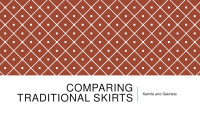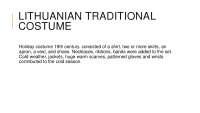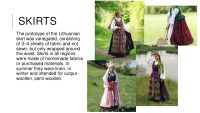Traditional Skirts Presentation



Comparing traditional skirts. Lithuanian traditional costume. Holiday costume 19th century. Consisted of a shirt, two or more skirts. The prototype of the Lithuanian skirt was variegated. Aukštaitija’s skirt. Above the shirt, the women wore wide ruffled skirts. Dzūkija’s skirt. The skirts of. Little Lithuania/ Klaipėda’s skirt. At the beginning. Žemaitija’s skirt. Žemaitija's skirts surprised. Suvalkija’s skirt. The most characteristic skirts of Suwalki were striped. Comparing. Scottish kilt is similar to our national women’s skirts.
Holiday costume 19th century. consisted of a shirt, two or more skirts, an apron, a vest, and shoes. Necklaces, ribbons, bands were added to the set. Cold weather, jackets, huge warm scarves, patterned gloves and wrists contributed to the cold season.
The prototype of the Lithuanian skirt was variegated, consisting of 3–4 sheets of fabric and not sewn, but only wrapped around the waist. Skirts in all regions were made of homemade fabrics or purchased materials. In summer they were linen, in winter and intended for output woollen, semi woollen.
Above the shirt, the women wore wide ruffled skirts, the upper of which was the most beautiful, woollen. The combination of green and red skirts prevailed.
The skirts of Dzūkija were checkered, woolen or semi woolen. The oldest examples are very reminiscent of the Aukštaitiškus. However, most of the later checkered skirts take on a distinctive style: the checkered patterns are simpler, the boxes are smaller, and the colors are more varied much blue, purple, dark red.
Žemaitija's skirts surprised by asymmetrical groups of stripes of different widths surprise with their masterful composition of colors and ingenious rhythm.
- Culture Presentations
- MS PowerPoint 26253 KB
- 2022 m.
- English
- 10 pages (404 words)
- Gymnasium
- Ema

















